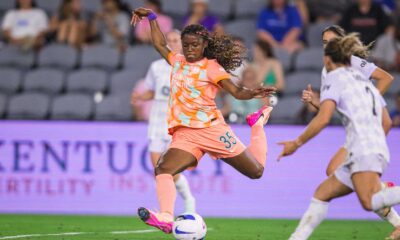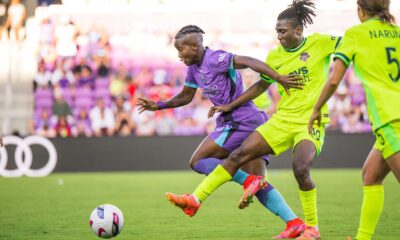Orlando Pride
Orlando Pride vs. Kansas City Current: A Tactical Deep Dive
How two of the NWSL’s best teams stymied each other en route to a critical draw.
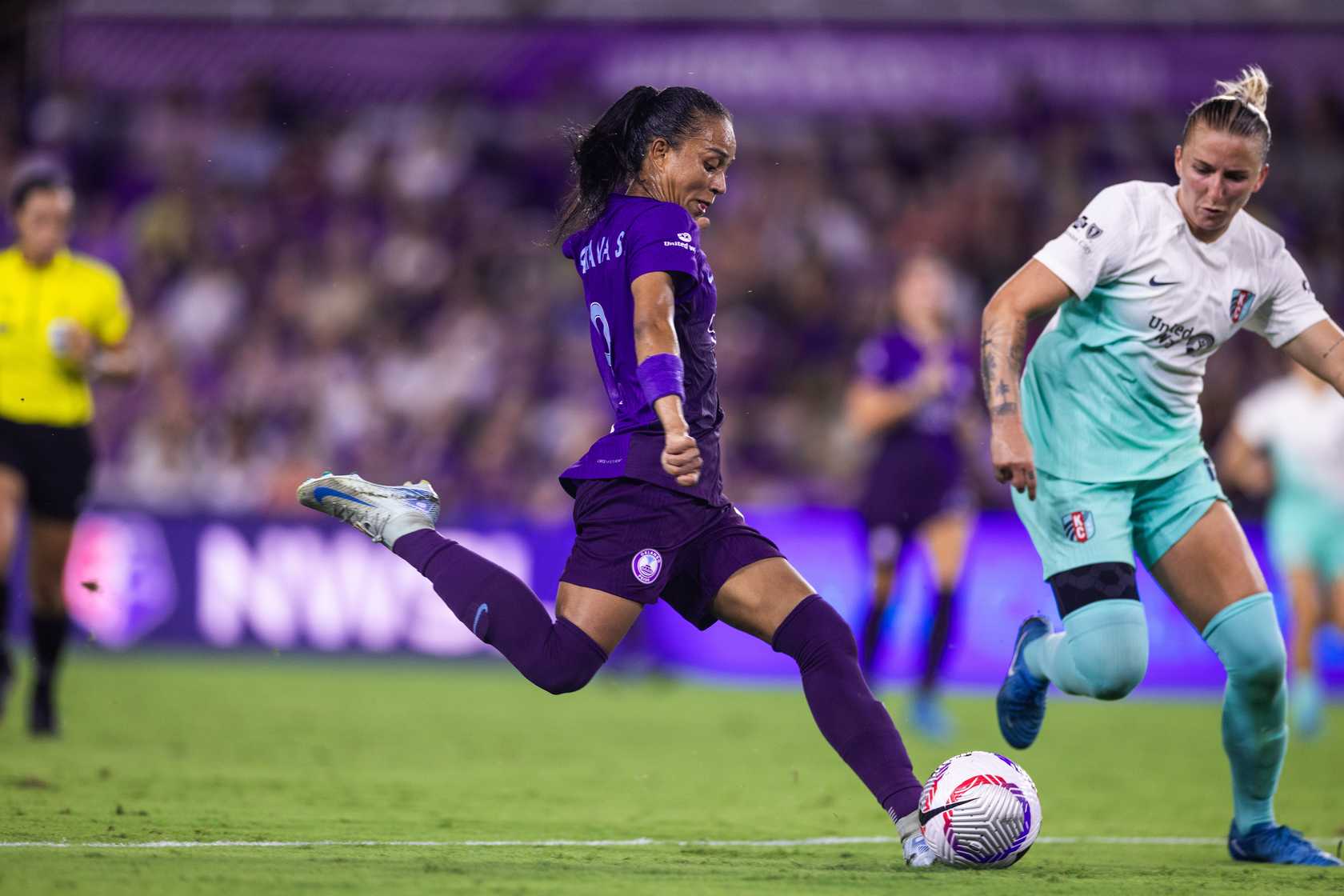
Friday night, nearly 10,000 fans packed Inter&Co Stadium to watch the much-anticipated rematch of two of the top teams in the NWSL. After a red card, a road win, and exuberant celebrations by the Orlando Pride at the Kansas City Current, the latter hoped for revenge in Orlando. Instead, the match played out more like a finely balanced chess match before the points were shared.
So, just how did a match featuring the two golden boot leaders in the NWSL, sitting on a combined 27 goals, end scoreless?
Slowing the Current
As it had been for most of the previous 19 matches of the season, defense was the star of the show for Orlando once again. This had to be the case for Orlando, considering the firepower Kansas City has on its roster. Below are the up-to-date goal contribution tallies for the Current, showing just how many players can hurt the opposition. Despite the potency of the Kansas City attack, the Pride were able to extend their clean sheet streak to four consecutive matches, with only one goal against in the past eight games, which was scored by the Current in Kansas City.
| Player | Goals | Assists |
| Temwa Chawinga | 15 | 6 |
| Bia Zaneratto | 5 | 4 |
| Lo’eau LaBonta | 5 | 1 |
| Vanessa DiBernardo | 4 | 5 |
| Debinha | 1 | 4 |
While Temwa Chawinga would have been top of mind for Orlando’s coaches while preparing for this matchup, they designed a comprehensive game plan for limiting the opportunities of the NWSL’s most potent attack that included all 11 positions on the pitch.
As Player of the Match Cori Dyke put it, “She’s obviously a player that demands a lot of respect. [She is] a really talented player. We did a lot of preparation this week, watched a lot of film, and went through a lot of defensive strategies.”
First among these defensive strategies was the high press that Head Coach Seb Hines employs against many opponents. Against the Current, the Pride began each defensive sequence from the front, engaging the Kansas City back line in a 4-2-4 pressing structure. In this formation, Summer Yates, Barbra Banda, Marta, and Adriana were each responsible for covering a counterpart in the opposition back line, limiting their options for easy passes. Then, when a defender played a ball back towards the keeper, Marta or Banda would trigger a more aggressive press and attempt to close down the ball and generate turnovers.
This high-press strategy often disrupted the flow of the game for Kansas City, but it can be a high-risk, high-reward strategy. If the Pride forced the Current to turn the ball over near their goal, it would create a dangerous chance for Orlando. On the other hand, if the press was unsuccessful, Kansas City could have numerical advantages on the other end of the pitch.
When Kansas City was able to play out from the back and around the Orlando press, the Current more often than not played it towards Chawinga on their left wing to drive towards the Orlando goal. In this match, she received the ball and carried it forward more often than an average match for her, but this is where the Pride had another strategy for limiting her chances. To slow Chawinga, they used Dyke as the primary defender, tasked with marking the golden boot pace-setter closely and had Emily Sams as secondary cover.
Dyke’s job was to push tight to Chawinga when she received the ball, enough to slow her down and give additional defenders time to engage. For Sams, the job was to cheat several yards back towards her own net when the Current possessed the ball, so as to not get beaten by Chawinga’s pace. When the ball did reach Chawinga, Sams would rush to double-team Chawinga and force the turnover or get the ball away from the Current’s most dangerous player. This tactic ensured that while Chawinga could not be completely prevented from influencing the play, it would be difficult for her to keep an attack headed towards Anna Moorhouse’s net.
The last key defensive tactic for the Pride in this match had just as much to do with Kansas City’s lack of endeavor as it did the Pride’s play. Kansas City knew coming into the match that it would be difficult to get a result in Orlando, so the visitors did not attack with the same conviction as they’ve become known for, instead focusing on transition and counterattacks to generate chances without opening the match up for the Pride to do the same.
Because of Kansas City’s offensive setup, the Pride were able to keep much of the game inside the Current’s half. With the distances reduced, the Pride front line and midfield were able to cover more players and passing lanes. So, when the Current progressed the ball initially, they were quickly covered again by an onrushing Angelina, Marta, or Banda, making life more difficult.
While Chawinga was able to create some threat for the Current — to the tune of five shots with two on target — the rest of the Kansas City squad only managed one shot on target. Vanessa DiBernardo, Lo’eau LaBonta, and Debinha all ended the match well below their season averages for shots, touches, and take-ons, a statistic showing how many times a player attempts to beat the opposition off the dribble. Beyond that, Kansas City only generated two corner kicks and four free kicks, resulting in minimal opportunities to commit bodies forward and create more than half chances. As the match progressed, it often seemed Kansas City wouldn’t be too bothered to play out a scoreless draw.
Pride Attack Stifled
Despite the fact that Orlando and Kansas City met as recently as July, a lot has changed in defense for the Current. Since that match, they have added center backs Alana Cook and Kayla Sharples and goalkeeper Almath Schult. These acquisitions were made to shore up several positions of weakness with an eye towards the NWSL championship. In just their second match as a new defensive unit, they played well, limiting Orlando’s chances. The Pride attack has experienced a bit of a drought in recent weeks, as analyzed by The Mane Land’s Andrew DeSalvo in a recent article. So, it is worth looking at what the Current did to stifle the Pride, and how the Pride could have found a way to win the match.
The Current’s defensive game plan against Orlando was simple, but it was effective. For the full 90 minutes of the match, when the Pride possessed the ball, the Current played a high defensive line and didn’t press the Orlando defenders, trying instead to create a congested middle of the pitch. This can be seen in the passing numbers for the Pride defenders, which were well above average in both number and accuracy of passes since there was absolutely no pressure on these players from the opposition.

On the other end of the pitch, Kansas City doubled up against Banda, with the goal of taking her influence out of the game. As a result, Banda had arguably her quietest night in a Pride jersey so far. On average, the Pride are able to find a pass to Banda 22 times per 90 minutes. Against Kansas City, this number was down to just 14 times. When Banda did receive a pass, she was hounded by defenders and unable to progress the ball into dangerous areas. While she averages an astounding six progressive carries per match, she only completed two against the Current. Without the ball, and unable to progress it into dangerous areas, Banda only took three shots versus her usual 5.5, and one was a speculative long-range effort that could’ve been better as a pass to Adriana.
In response to Kansas City’s defensive setup, the opportunities for Orlando came from the wide areas of the pitch. Because of the attention paid to clogging up the middle and double-teaming Banda, Orlando created many one-on-one matchups for Adriana against the opponent. Unfortunately, Hailie Mace defended superbly from the left back position and Adriana could not get anything going. While Adriana possessed the ball roughly twice as much as Banda, she was unable to create opportunities to score. She attempted eight take-ons against Mace, but beat her once, and by the end of the match she had only managed one shot on target and was largely ineffective.
On the other wing, Yates did not have much more success, despite receiving the ball about as many times as Adriana in only 59 minutes. Off the left wing, she similarly only beat her opponent once out of five attempts. Yates was replaced by Evelina Duljan without registering a shot. Duljan, for her part, was quite lively after her introduction. In her 31 minutes, she was able to beat her opponent three times in one-on-one situations, and her progressive carries led to several dangerous situations for the attack in the closing minutes.
In addition to Duljan, the other offensive standout for the Pride was Marta. Of all Orlando’s players, she looked the most likely to create the chance that would’ve won the game. Despite the Current’s tactic of compressing the pitch and clogging the middle, Marta’s movement off the ball and exceptional footwork meant she was able to find pockets of space to receive a pass, turn out of trouble, and transition into attack. As a result, Marta received 51 passes in the match, more than double the next highest tally from front-line players, often because she dropped deep to receive. From there, her 43 completed passes also doubled the tally of any other attacker. Each of the two times she took on a defender, she was able to beat them. Finally, Marta accounted for three of Orlando’s five shots on target, all of which were taken outside the box and required diving saves from Schult.
In the end, Hines said it best, “Kansas were a tough nut to crack at times. You know, they got a lot of bodies behind the ball. They made it very difficult for us to try and create anything. I also think there was quite some good opportunities to score as well.”
Missed Opportunities
As Hines said, despite the solid defending by the opposition, there were a few ways that the Pride weren’t as effective in their attacking play as the coaching staff has come to expect. Some of these missed opportunities were mentioned above, like the wingers not winning their individual matchups against the opposing defense. Another way the Pride could have created chances for themselves, but didn’t, was the high pressing discussed above. While the Current showed a solid game plan for preventing chances when Orlando built from the back, turnovers created in the defensive third can shred a game plan and yield scoring chances. Unfortunately, Orlando was not able to generate a killer turnover in this match.
Another missed opportunity was the lack of threat from set plays. Orlando generated many set pieces, including eight corners and 11 free kicks in total, but these also did not yield a goal. Many times, corners were lofted into an area where the keeper was always favored to reach the ball. Better delivery could have seen a winning goal from Banda, who is already the all-time leader in headed goals for the Pride. Other times, the ball just did not bounce the right way for a rebound. A few of the chances that did come from these set plays fell to Haley McCutcheon, but the defensive midfielder was not able to put any of her four shots on frame.
Holding a talented opponent scoreless is always an accomplishment that requires a good plan, good execution, and sometimes a bit of luck. Fans in Inter&Co stadium didn’t get to see a goal, but they did see interesting tactics and great defense. While this may be biased towards the team in purple, the Pride generally seemed the more likely to come out victorious in this matchup as they had more possession, shots, shots on target, and set-piece opportunities than the opposing Kansas City Current.
At the end of the day, the points were split, and this too may lean in the favor of the Pride. For the Current, one point meant falling behind Gotham in the standings. They may also be running out of time to catch back up to the NWSL shield leaders after leading the league for much of the first half of the season. For Orlando, a point means a continuing undefeated run that now stretches to 21 matches. However, after the Spirit defeated the Houston Dash, Orlando’s lead at the top of the table now sits at four points, and a match between the top two teams is just a few weeks away.
Orlando Pride
Orlando Pride vs. Racing Louisville: Final Score 2-0 as Pride Still Can’t Win in Kentucky
The Pride lacked quality but not effort in a frustrating 2-0 road loss at Louisville.
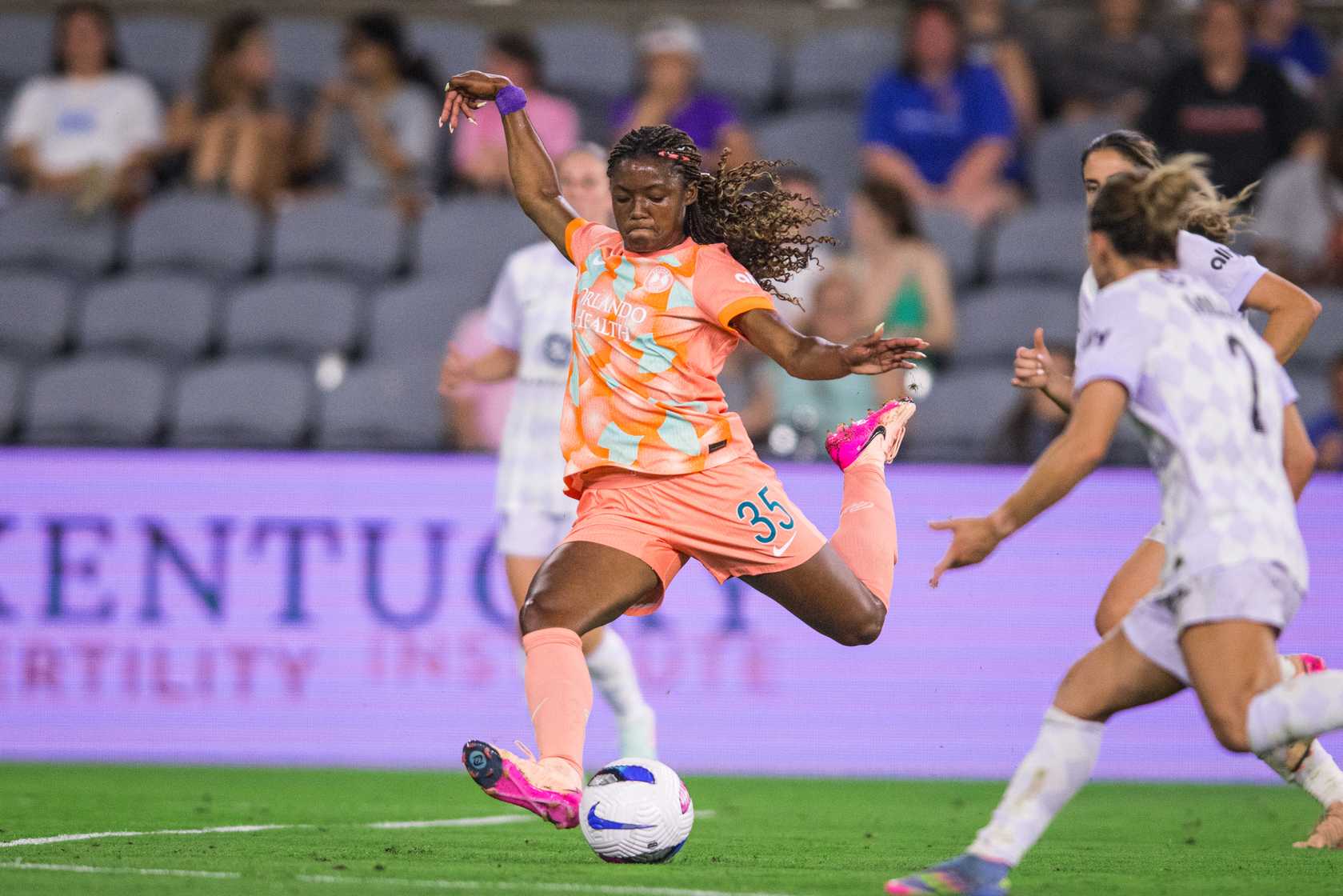
The Orlando Pride were looking to end the first half of the season on a high note, but ended up doing just the opposite in a forgettable performance at Lynn Family Stadium in Louisville. Orlando (8-4-1, 25 points) continued to waste scoring opportunities, but instead of playing the stalwart defense of the last couple of games, the Pride also failed to mark at the back post on a set piece and conceded an unnecessary penalty to gift the hosts a two-goal advantage in a 2-0 loss to Racing Louisville (6-5-2, 20 points).
Center back Arin Wright scored her first goal of the season and Taylor Flint added a penalty kick goal for Racing. The Pride dropped to 0-4-1 at Louisville since the series began and fell eight points adrift of first-place Kansas City, although the focus for now should perhaps be on finding their offense rather than catching the Current.
“Obviously disappointed with the result,” Orlando Pride Head Coach Seb Hines said after the match. “It’s come down to two set pieces.”
Hines’ starting lineup included goalkeeper Anna Moorhouse behind a back line of Cori Dyke, Kylie Nadaner, Emily Sams, and Ohihane. Haley McCutcheon and Angelina were the central midfielders with Summer Yates and Ally Watt outside and Marta and Barbra Banda up top.
Louisville came out pressing high and pinning Orlando back in its own end. The Pride eventually settled into the game, worked hard and seized the advantage in terms of possession and chances. However, they were wasteful with their few clear-cut opportunities, and rather than build an early lead, Orlando ended up gifting Racing an early advantage and had to play catch-up — something the Pride simply couldn’t do on this night.
Marta was called for an early foul that she knew little about, jumping up between two defenders. Ary Borges backed into her space, and there was contact, with Marta getting saddled with the foul. Sarah Weber got her head to the cross on the free kick, sending it just inches over the crossbar and onto the roof of the net in the fourth minute.
Orlando’s first shot came in the seventh minute after the Pride broke Racing’s pressure. The ball found Banda, who cut inside from left to right and fired from the top of the box. The Zambian international left her shot too close to goalkeeper Jordyn Bloomer, who got down and made the save.
The Pride suffered a blow moments later as Oihane went down without contact trying to keep a ball in play at the sideline. She was clearly in a lot of pain and had to be subbed off. While waiting for the sub, the game played on with Orlando using just 10 players.
Racing kept the pressure on and that resulted in shots from distance as the Pride left too much space just outside the area. Taylor Flint had a go from 30 yards out but sent her rising effort over the bar in the 11th minute. A minute later, Savannah DeMelo sent a shot from the top of the area over the goal.
Hines was finally able to send Kerry Abello on in the 13th minute, slotting her in on the left and moving Dyke to right back.
McCutcheon’s foul near the left corner of the box just past the quarter-hour mark gave Louisville a dangerous set piece shortly after the substitutions. DeMelo fired the free kick on target, and Moorhouse caught it and then got bundled over by Ary Borges who was pressed from behind by Sams.
Orlando started to settle into the game a bit after that, but did not execute well in the attack. Banda allowed Ellie Jean to knock the ball away from her in the box in the 17th minute. Moments later, Marta’s set piece delivery into the box from near the right corner of the penalty area was too low and easily cleared.
The Pride started winning corners but took all of them short, possibly to avoid Racing’s height, but they created nothing with the opportunities except a few long-range shots. On the first, Yates was knocked down in the box in the 23rd minute after getting to the end line, but the referee ruled it was a fair challenge.
Orlando should have scored in the 28th minute. Watt put in a fantastic cross to a wide-open Yates at the back post. With plenty of open net to shoot at, Yates pushed her free header wide of the left post, wasting a sitter.
“I mean, goals change games,” Hines said. “We had a chance just before their set piece (goal) where the ball gets to Ally (Watt), she takes on Courtney Petersen, puts in a really good cross. And (Yates) gets her head on it, but it wasn’t on target. And I think if that had gone in, it might have changed the trajectory of the game. You know, you’re then asking Louisville to be even more aggressive. There’s more space for us to manipulate.”
A minute later, the game turned in Louisville’s favor. Banda was too indecisive after receiving the ball in the attacking third. Leaving the ball at her feet and trying to head fake, Racing easily dispossessed the forward and broke in transition, winning a corner at the other end. Louisville paid off the set piece when Orlando left two players completely unmarked at the back post. Unlike Yates earlier, Wright got her head on the ball and didn’t miss the net, putting the hosts up 1-0 in the 30th minute. Former Pride fullback Courtney Petersen got the assist for her delivery.
Angelina fired from outside the box on a couple of short corners but the first, which may have been a back-post pass to Nadaner, went wide and out of play in the 34th minute.
Orlando again should have scored in the 35th minute. Watt did well to steal the ball in the attacking third and immediately played it to Banda. The goalkeeper was caught out, but Banda was deliberate in lining up her shot. Once she did, she missed the net entirely.
Watt had a chance to cross into the box in the 38th minute but sent her service right at Bloomer. Angelina fired a good effort from distance in the 40th minute. The dipping shot was on target but Bloomer was able to knock it out for a corner. Orlando played it short again and Angelina fired from distance only to see it deflect out off a defender. The Brazilian then ended up with yet another shot from range on the next corner, but sent it right at Bloomer.
Banda had a chance to play Marta in alone in the first minute of stoppage time, but she didn’t get enough on the pass. Flint was able to close down and knock it out for another corner. Nothing came of that one either, and moments later the half was over with the Pride staring up at a 1-0 deficit in a game they probably should have led.
The Pride finished the first half with the advantage in possession (57%-43%), shots (9-7), shots on target (4-2), corners (6-1), and passing accuracy (82%-79%). But the wasted opportunities and moment of inattentive set piece defending had the hosts out front at the break.
Hines made his second change at the half, sending Carson Pickett on for Yates. After the match, Hines said Yates hadn’t been feeling well and needed to come off, so she became the second unexpected substitution of the match.
“It kind of disrupted the momentum that we had in the first half going into the second half,” Hines said of sacrificing Oihane and Yates. “But we have good players who can adapt, and so I thought we still put them under pressure going to the second half, playing through the press.”
Louisville started the second half much like the first — as the aggressor. Emma Sears blasted wide just after the restart. On the ensuing goal kick, Orlando quickly turned it over and Borges ended up in alone on goal with the ball. With just Moorhouse to beat, the Brazilian smashed the ball off the right post, wasting an opportunity to make it 2-0 in the 49th minute.
Orlando’s first attack of the second half came in the 50th minute and it quickly broke down. Banda tried to find Pickett as she approached the box, but she made a mess of the pass and the defense cleared. The ball went to Marta at the top of the area, and the Pride captain saw her shot blocked. The rebound found Banda, who send a soft shot straight at Bloomer.
“I just think at this moment in time, everyone’s kind of adapted to us,” Hines said. “We’re getting into really good, promising positions, and we just need to execute in that last final part.”
Wright did well to keep a cross from reaching McCutcheon at the back post in the 53rd minute. Both players needed treatment after a clash of heads and were off the pitch for a few minutes.
Sears nearly made it 2-0 in the 61st minute, losing Dyke in the corner, cutting inside and must missing the far post by about a yard.
Louisville put the game away a few minutes later. On a routine throw-in, Sams was positioned well behind Weber just inside the box near the right sideline. Rather than hold her position, she tried to muscle her way around the Louisville forward, pulling her down. The referee pointed to the spot immediately.
Former Pride midfielder Flint took the spot kick. Moorhouse guessed correctly, but Flint placed the shot well to make it 2-0 in the 68th minute.
Shortly after the second goal, Hines pulled Marta, McCutcheon, and Dyke, subbing on Morgan Gautrat, Ally Lemos, and Simone Jackson, who made her NWSL debut. Those three were not likely to provide the missing piece of the attack, and they didn’t, as Orlando continued to struggle in the offensive third.
Banda put a shot on frame from a tight angle on the right in the 78th minute, but it was a comfortable save for Bloomer. The ball fell in the box near the end line where Wright was prone. Banda ran in to try to win it, but Wright wisely knocked it out off the Zambian for a goal kick.
Weber nearly made it 3-0 on another Louisville corner kick opportunity in the 80th minute. This one was slightly more contested than Wright’s and Weber put her shot wide.
Down the stretch, Orlando wasted a couple more short corners and simply couldn’t find any lethality. Banda missed the net four times in the game’s final minutes on what was an apparently frustrating night for the Golden Boot contender.
Orlando’s statistical advantage was not reflective of the final score. The Pride finished with the edge in possession (64%-36%), shots (16-14), shots on target (7-3), corners (11-3), and passing accuracy (82%-74%).
“I learned that nothing’s given, no matter what rank you are as a team,” Jackson said after making her pro debut. “So, it’s like everyone is coming after you. You have a target on your back when you wear this badge. So, I think it was wake-up call for a lot of us, and I think that I’m excited for the second half of this season.”
The Pride have a long break to stew in this performance, as the NWSL schedule won’t resume for several weeks. Orlando’s next NWSL is Aug. 3, when the Utah Royals visit Inter&Co Stadium.
Orlando Pride
Orlando Pride vs. Racing Louisville FC: Preview, How to Watch, TV Info, Live Stream, Lineups, Match Thread, and More
The Pride head to Louisville to wrap up the first half of the NWSL season ahead of the summer break.
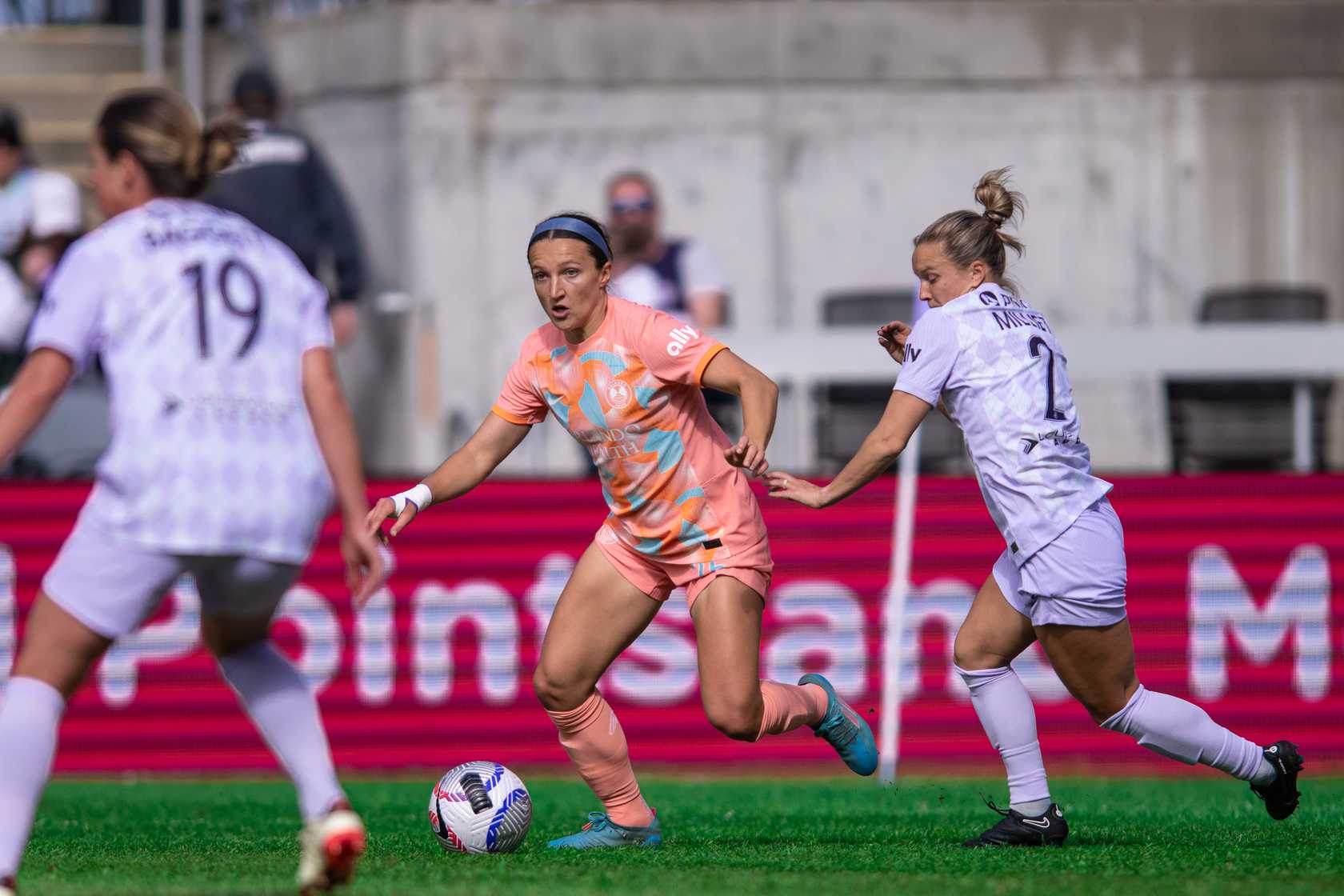
Welcome to your match preview as the Orlando Pride (8-3-1, 25 points) end the first half of the 2025 NWSL season against Racing Louisville (5-5-2, 17 points) in Kentucky. This is the first of two meetings with the second scheduled for Aug. 9 in Orlando.
Here’s everything you need to know about tonight’s game.
History
This is the fifth season of existence for Racing Louisville. The two teams have played 11 times so far, with the Pride going 3-3-5 (3-3-3 in NWSL games, 0-0-1 in the NWSL Challenge Cup, and 0-0-1 in the NWSL x Liga MX Fememil Summer Cup). The Pride are 0-3-1 against Louisville on the road in league play.
The most recent meeting between the two teams occurred in the Summer Cup last year on Aug. 1, 2024. Evelina Duljan scored her lone Pride goal in the 38th minute to give the Pride the lead. However, Reilyn Turner equalized in the 67th minute, sending the game into penalties. The Pride took the early shootout lead when Jaelin Howell missed, but saves by Jordyn Bloomer on Morgan Gautrat and Ally Watt saw Louisville take the extra point.
On May 5, 2024, in Orlando, an Emily Sams cross in the 17th minute found the head of Barbra Banda at the back post for the game’s only goal in a 1-0 Pride win. The first game of the 2024 season was on March 16 in Louisville, the season opener for both teams. It looked like it would be a long day as Elexa Bahr and Uchenna Kanu gave the hosts a 2-0 lead inside 20 minutes. The Pride got on the board in the 24th minute with an own goal by Elli Pikkujämsä, but the task was made more difficult when Kylie Strom received her second yellow card in the second half. However, Amanda Allen and Summer Yates combined on a late goal by Yates, as the Pride pulled out an unlikely 2-2 draw.
The first game of 2023 occurred on May 6 at Exploria Stadium. Messiah Bright gave the Pride an early lead and the hosts held on for 69 minutes for the 1-0 win. It was the first home win of 2023 for the Pride and their second win of the season. The second meeting was on Oct. 6, 2023 in Louisville. The Pride got off to a great start with goals by Marta from the spot early and an excellent individual effort by Kerry Abello to make it 2-0. However, Bright took Savannah DeMelo down in the box just before halftime and Nadia Nadim converted the penalty. A five-minute swing started in the 70th minute with goals by Kristen Davis and an own goal by Pride goalkeeper Anna Moorhouse, resulting in the Pride losing the critical game 3-2.
The first meeting between the two teams in 2022 took place Sept. 16 in Louisville. Racing struck first when Nadim was left open in front of goal for a tap-in. The hosts doubled their lead on a great strike by DeMelo from outside of the box, and the Pride fell 2-0.
The first meeting of 2022 was in a unique setting, taking place at Daytona International Speedway on July 3. The game was a part of the 2022 Daytona SoccerFest and was the first time a professional soccer game was played at a racetrack. Emina Ekic gave Louisville a halftime lead and DeMelo doubled the lead shortly after the break. However, the Pride fought back with goals by Strom and Darian Jenkins, pulling out a 2-2 draw. The game launched a seven-game unbeaten run that pulled the Pride back into the playoff race.
The first year the two teams met was in 2021 during the NWSL Challenge Cup in Louisville. CeCe Kizer gave the hosts the lead early, but Taylor Kornieck equalized just before halftime. It looked like the Pride would win when Abi Kim scored late, but Brooke Hendrix equalized in second-half injury time and the teams drew 2-2.
The teams played three times in the 2021 regular season, with the first meeting coming on July 9 in Orlando. Ebony Salmon gave Louisville the lead, but Sydney Leroux scored to force a 1-1 draw with a goal in second-half injury time. The second meeting was on Sept. 11 in Orlando. The Pride took a 2-0 lead into the break with goals by Leroux and Marta. Kizer got one back, but Alex Morgan’s conversion sealed three points for the Pride.
The final meeting of 2021 was in the penultimate game of the year for both teams. The Pride needed a win to keep their playoff hopes alive and they got off to a good start when Jodie Taylor scored in the third minute. However, the game slipped away as Salmon and Katie McClure scored on either side of halftime and Yuki Nagasato made the final 3-1.
Overview
A month ago, the Pride’s season was in question. Despite a strong start, they were winless in three straight games and four out of five, falling down the NWSL standings. But they’ve responded well to that adversity, winning three straight.
It started on May 23 when Banda netted the first hat trick in Pride history in a 3-1 win over the Utah Royals. They returned home on June 7 to defeat the Houston Dash 1-0 and took advantage of a quick free kick against Bay FC for a second consecutive 1-0 win.
Banda’s goal in San Jose was her eighth of the season, placing her in a tie for second with Kansas City’s Temwa Chawinga. The African pair are only one goal behind NJ/NY Gotham FC’s Esther Gonzlalez for the league lead in goals.
While Banda is one of the league’s top scorers, it’s the defense that has the team near the top of the NWSL standings. The win in California was the Pride’s fifth clean sheet this season. They’ve now won three games this year 1-0 and have still only conceded multiple goals in one game, a 3-2 win over Angel City FC on April 25.
The Pride now sit in second place, just five points behind the Kansas City Current and two points ahead of the San Diego Wave. More importantly, they’ve created momentum heading into the summer break for the 2025 Euros. They’ll desperately want all three points tonight, which would see them enter the break on a four-game winning streak. To do that, they’ll need to win somewhere they’ve never won.
Standing in their way is Racing Louisville, the seventh-place team in the league. Tonight’s opponent has been strong offensively, scoring 17 goals. But Racing’s 22 goals conceded are fourth most. Its -5 goal differential is also fourth worst in the league.
Louisville is led offensively by Emma Sears, who has six goals. Taylor Flint, Kayla Fischer, and DeMelo are tied for second on the team with two goals this season. Janine Sonis leads the team with three assists, followed by Arin Wright, Fischer, and DeMelo, each with two assists.
Louisville went into its last game with a pair of 3-2 wins over Angel City away and the Utah Royals at home. However, the Kentucky-based club went to Kansas City on June 14 to face the league leaders, falling 4-2.
“Physical game,” Pride Head Coach Seb Hines said ahead of tonight’s match. “I think what (Louisville Head Coach) Bev (Yanez) has done in the last five or six games is implemented a different style of play. A very aggressive, high-pressing team now and they’ve had a lot of success with it. They’ll be wanting to bounce back from their last result against Kansas and try to finish this period on a high leading up into the summer break.”
The Pride are still without Simone Charley (ankle), Luana (illness), Amanda Allen (shoulder), and Rafaelle (thigh). Julie Doyle (ankle) has been added to the availability report this week, listed as questionable.
Louisville is without Bethany Balcer (excused absence), Fischer (suspended), Katie Lund (hip), Maddie Pokorny (hip), Olivia Sekany (knee), and Kirsten Wright (knee).
Official Lineups
Orlando Pride (4-4-2)
Goalkeeper: Anna Moorhouse.
Defenders: Cori Dyke, Kylie Nadaner, Emily Sams, Oihane.
Midfielders: Summer Yates, Angelina, Haley McCutcheon, Ally Watt.
Forwards: Barbra Banda, Marta.
Bench: McKinley Crone, Carson Pickett, Kerry Abello, Zara Chavoshi, Viviana Villacorta, Morgan Gautrat, Ally Lemos, Simone Jackson, Prisca Chilufya.
Racing Louisville (4-3-3)
Goalkeeper: Jordyn Bloomer.
Defenders: Courtney Petersen, Arin Wright, Ellie Jean, Lauren Milliet.
Midfielders: Ary Borges, Taylor Flint, Savannah DeMelo.
Forwards: Emma Sears, Sarah Weber, Janine Sonis.
Bench: Cristina Roque, Elli Pikkujamsa, Ella Hase, Angela Baron, Marisa DiGrande, Jordan Baggett, Avery Kalitta, Katie O’Kane, Uchenna Kanu.
Referees
REF: John Matto.
AR1: Stephen Milhoan.
AR2: Brian Marshall.
4TH: Race Williams.
VAR: Anya Voigt.
AVAR: Melissa Beck.
How to Watch
Match Time: 8 p.m.
Venue: Lynn Family Stadium — Louisville, KY.
TV: None
Streaming: FanDuel Sports Network app, NWSL+.
Social Media: For live updates and rapid reaction, follow @themaneland.bsky.social on Bluesky and the Orlando Pride’s official Twitter (@ORLPride) or Bluesky (@orlpride.com) feed.
Enjoy the game. Go Pride!
Orlando Pride
Orlando Pride vs. Racing Louisville: Three Keys to Victory
What do the Pride need to do to secure a victory against Racing Louisville on the road?
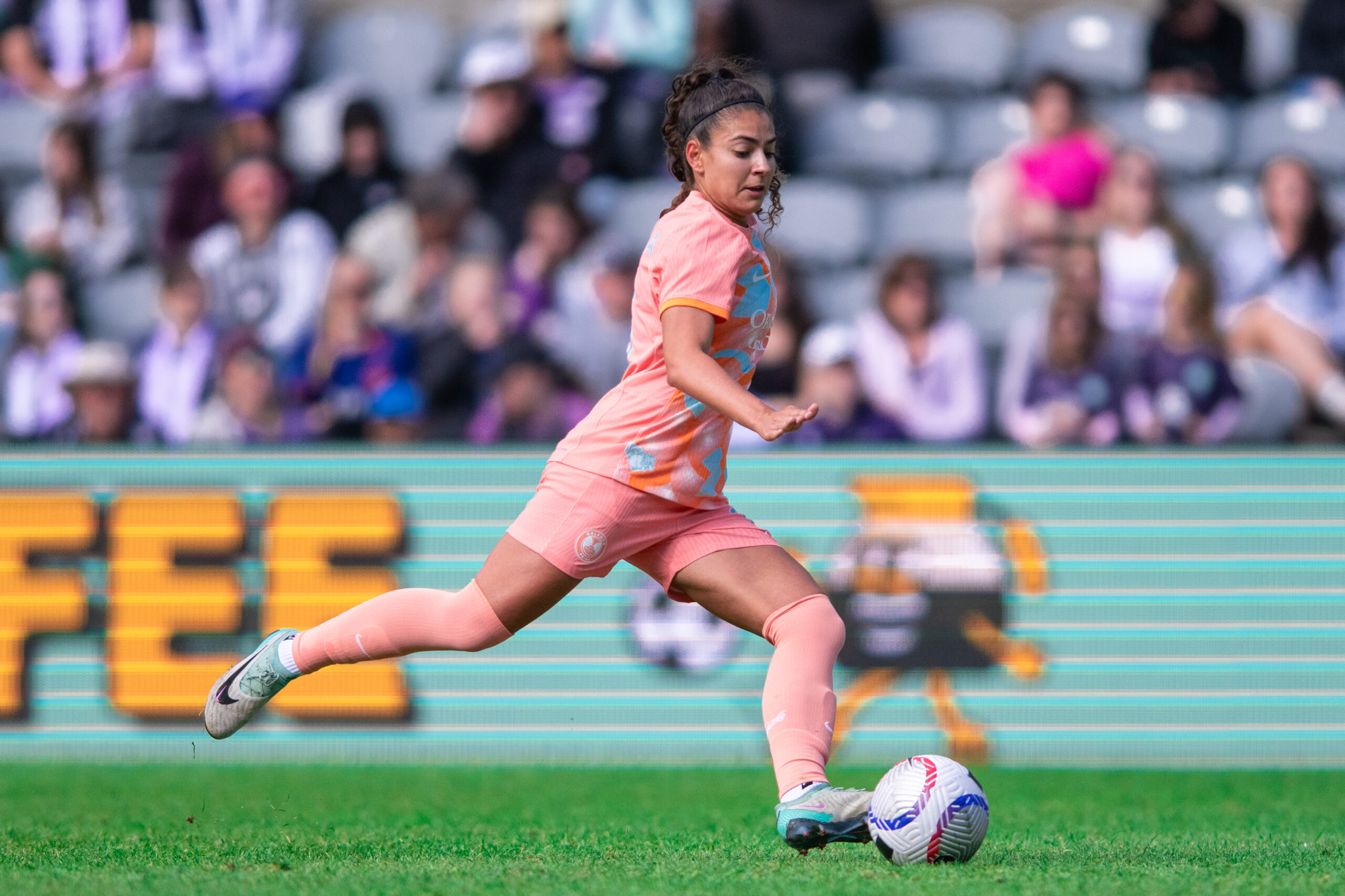
The Pride are riding a three-match winning streak heading into Friday’s match against Racing Louisville — the team’s final game before the NWSL’s summer break. Given this is the last match until August, it is important that the Pride make a statement and leave an impression on the competition. What do the Pride need to do to take all three points from Racing Louisville at Lynn Family Stadium Friday night?
More Offense
The Orlando Pride have scored six goals in the last six matches. That might not seem too bad, but three of those goals came on Barbra Banda’s hat trick against the Utah Royals. That means in the other five matches, the Pride have only scored three goals. That isn’t enough for a team that wants to repeat the double.
I don’t think the team has found a proper replacement for the departed Adriana. Seb Hines has tried using Ally Watt, Prisca Chilufya, and Julie Doyle, though none have contributed to a commensurate level. Without another threat up top, teams can focus more heavily on Banda, making it difficult for her to score. Hines needs someone to step it up a notch by being a legitimate scoring threat, thus freeing Banda to deal with only two defenders and not three or four. This is the last chance before the break to figure it out.
Stop Sears and Co.
The Pride will face a capable Racing Louisville offense. Emma Sears leads the way for Louisville with six goals this season. The opposition also has Savannah DeMelo, Taylor Flint (née Kornieck), and Kayla Fischer. Louisville has 17 goals this season compared to the 20 scored by Orlando. I’m saying that Louisville is a legitimate threat.
I feel that Hines found the best back line in the last match with Oihane at right back, Emily Sams and Kylie Nadaner at center back, and Cori Dyke on the left. This is the back four that I think will provide the best defense in front of Anna Moorhouse. That is the back line that will need to deal with Sears and the others. A clean sheet may be a lot to ask on the road, but this defense could make it happen.
Back to Basics
The last few matches the Pride have taken short corners at almost every opportunity presented. Please stop doing that. No more Pepper Shakers or Loki’s Toboggan — see Ted Lasso season 1, episode 10. Put the ball in the box and let things happen. Between Marta, Angelina, Carson Pickett, and Summer Yates, the Pride have enough players who can put in a good ball from a corner kick or free kick.
Weird and sometimes wonderful things happen when you simply put the ball in the box. A player can score a header, the ball can bounce to a player for a shot, there could be an own goal, or even a handball resulting in a penalty. Yes, the ball might go out for a goal kick or a Pride player could commit a foul, but the team’s success rate on short corners is not good and Orlando has capable scorers who can finish in close. Leave the tricksy training ground antics at home and put the ball in the darn box.
That’s what I’ll be looking for Friday night. Where do you think the game will be won or lost? Let us know in the comments section.
-

 Local Soccer Events4 days ago
Local Soccer Events4 days agoUlsan HD FC vs. Mamelodi Sundowns FC: Final Score 1-0 as South African Side Wins First FIFA Club World Cup Match in Orlando
-
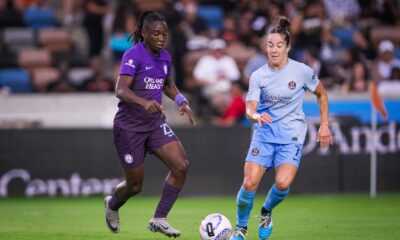
 Orlando Pride2 weeks ago
Orlando Pride2 weeks agoOrlando Pride vs. Houston Dash: Preview, How to Watch, TV Info, Live Stream, Lineups, Match Thread, and More
-

 Orlando Pride1 week ago
Orlando Pride1 week agoOrlando Pride vs. Bay FC: Preview, How to Watch, TV Info, Live Stream, Lineups, Match Thread, and More
-

 Orlando City1 week ago
Orlando City1 week agoOrlando City vs. Colorado Rapids: Final Score 1-0 as Ojeda’s Goal Snatches Road Win for Lions
-
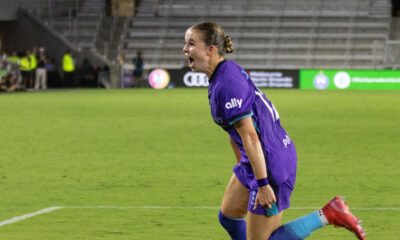
 Orlando Pride2 weeks ago
Orlando Pride2 weeks agoOrlando Pride vs. Houston Dash: Final Score 1-0 as Cori Dyke’s Goal at the Death Lifts Pride
-
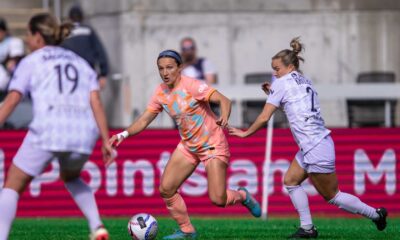
 Orlando Pride2 days ago
Orlando Pride2 days agoOrlando Pride vs. Racing Louisville FC: Preview, How to Watch, TV Info, Live Stream, Lineups, Match Thread, and More
-

 Orlando City1 week ago
Orlando City1 week agoOrlando City vs. Colorado Rapids: Preview, How to Watch, TV Info, Live Stream, Lineups, Match Thread, and More
-
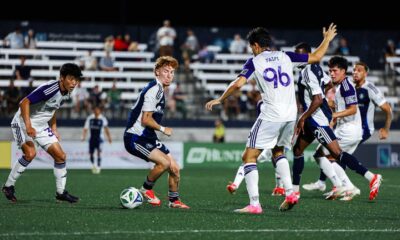
 Podcasts2 weeks ago
Podcasts2 weeks agoPawedCast Episode 484: OCB Beats Huntsville, Alex Freeman’s USMNT Debut, Colorado Preview, and More


